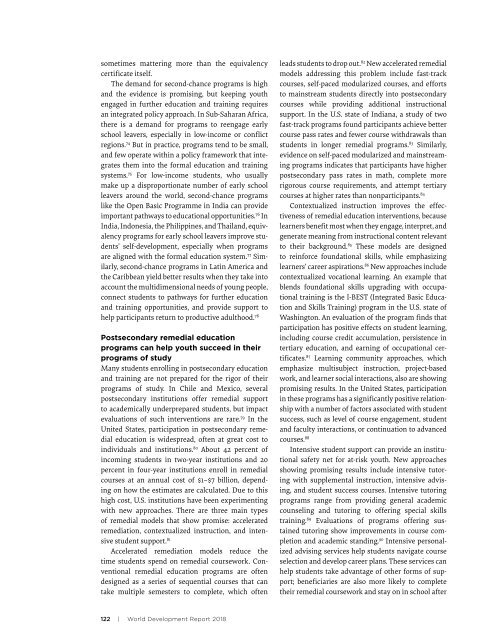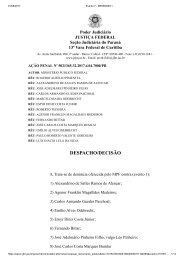Brasil só deve dominar Leitura em 260 anos, aponta estudo do Banco Mundial Relatorio Banco Mundial _Learning
Create successful ePaper yourself
Turn your PDF publications into a flip-book with our unique Google optimized e-Paper software.
sometimes mattering more than the equivalency<br />
certificate itself.<br />
The d<strong>em</strong>and for second-chance programs is high<br />
and the evidence is promising, but keeping youth<br />
engaged in further education and training requires<br />
an integrated policy approach. In Sub-Saharan Africa,<br />
there is a d<strong>em</strong>and for programs to reengage early<br />
school leavers, especially in low-income or conflict<br />
regions. 74 But in practice, programs tend to be small,<br />
and few operate within a policy framework that integrates<br />
th<strong>em</strong> into the formal education and training<br />
syst<strong>em</strong>s. 75 For low-income students, who usually<br />
make up a disproportionate number of early school<br />
leavers around the world, second-chance programs<br />
like the Open Basic Programme in India can provide<br />
important pathways to educational opportunities. 76 In<br />
India, In<strong>do</strong>nesia, the Philippines, and Thailand, equivalency<br />
programs for early school leavers improve students’<br />
self-<strong>deve</strong>lopment, especially when programs<br />
are aligned with the formal education syst<strong>em</strong>. 77 Similarly,<br />
second-chance programs in Latin America and<br />
the Caribbean yield better results when they take into<br />
account the multidimensional needs of young people,<br />
connect students to pathways for further education<br />
and training opportunities, and provide support to<br />
help participants return to productive adulthood. 78<br />
Postsecondary r<strong>em</strong>edial education<br />
programs can help youth succeed in their<br />
programs of study<br />
Many students enrolling in postsecondary education<br />
and training are not prepared for the rigor of their<br />
programs of study. In Chile and Mexico, several<br />
postsecondary institutions offer r<strong>em</strong>edial support<br />
to acad<strong>em</strong>ically underprepared students, but impact<br />
evaluations of such interventions are rare. 79 In the<br />
United States, participation in postsecondary r<strong>em</strong>edial<br />
education is widespread, often at great cost to<br />
individuals and institutions. 80 About 42 percent of<br />
incoming students in two-year institutions and 20<br />
percent in four-year institutions enroll in r<strong>em</strong>edial<br />
courses at an annual cost of $1–$7 billion, depending<br />
on how the estimates are calculated. Due to this<br />
high cost, U.S. institutions have been experimenting<br />
with new approaches. There are three main types<br />
of r<strong>em</strong>edial models that show promise: accelerated<br />
r<strong>em</strong>ediation, contextualized instruction, and intensive<br />
student support. 81<br />
Accelerated r<strong>em</strong>ediation models reduce the<br />
time students spend on r<strong>em</strong>edial coursework. Conventional<br />
r<strong>em</strong>edial education programs are often<br />
designed as a series of sequential courses that can<br />
take multiple s<strong>em</strong>esters to complete, which often<br />
leads students to drop out. 82 New accelerated r<strong>em</strong>edial<br />
models addressing this probl<strong>em</strong> include fast-track<br />
courses, self-paced modularized courses, and efforts<br />
to mainstream students directly into postsecondary<br />
courses while providing additional instructional<br />
support. In the U.S. state of Indiana, a study of two<br />
fast-track programs found participants achieve better<br />
course pass rates and fewer course withdrawals than<br />
students in longer r<strong>em</strong>edial programs. 83 Similarly,<br />
evidence on self-paced modularized and mainstreaming<br />
programs indicates that participants have higher<br />
postsecondary pass rates in math, complete more<br />
rigorous course requir<strong>em</strong>ents, and att<strong>em</strong>pt tertiary<br />
courses at higher rates than nonparticipants. 84<br />
Contextualized instruction improves the effectiveness<br />
of r<strong>em</strong>edial education interventions, because<br />
learners benefit most when they engage, interpret, and<br />
generate meaning from instructional content relevant<br />
to their background. 85 These models are designed<br />
to reinforce foundational skills, while <strong>em</strong>phasizing<br />
learners’ career aspirations. 86 New approaches include<br />
contextualized vocational learning. An example that<br />
blends foundational skills upgrading with occupational<br />
training is the I-BEST (Integrated Basic Education<br />
and Skills Training) program in the U.S. state of<br />
Washington. An evaluation of the program finds that<br />
participation has positive effects on student learning,<br />
including course credit accumulation, persistence in<br />
tertiary education, and earning of occupational certificates.<br />
87 <strong>Learning</strong> community approaches, which<br />
<strong>em</strong>phasize multisubject instruction, project-based<br />
work, and learner social interactions, also are showing<br />
promising results. In the United States, participation<br />
in these programs has a significantly positive relationship<br />
with a number of factors associated with student<br />
success, such as level of course engag<strong>em</strong>ent, student<br />
and faculty interactions, or continuation to advanced<br />
courses. 88<br />
Intensive student support can provide an institutional<br />
safety net for at-risk youth. New approaches<br />
showing promising results include intensive tutoring<br />
with suppl<strong>em</strong>ental instruction, intensive advising,<br />
and student success courses. Intensive tutoring<br />
programs range from providing general acad<strong>em</strong>ic<br />
counseling and tutoring to offering special skills<br />
training. 89 Evaluations of programs offering sustained<br />
tutoring show improv<strong>em</strong>ents in course completion<br />
and acad<strong>em</strong>ic standing. 90 Intensive personalized<br />
advising services help students navigate course<br />
selection and <strong>deve</strong>lop career plans. These services can<br />
help students take advantage of other forms of support;<br />
beneficiaries are also more likely to complete<br />
their r<strong>em</strong>edial coursework and stay on in school after<br />
122 | World Development Report 2018








